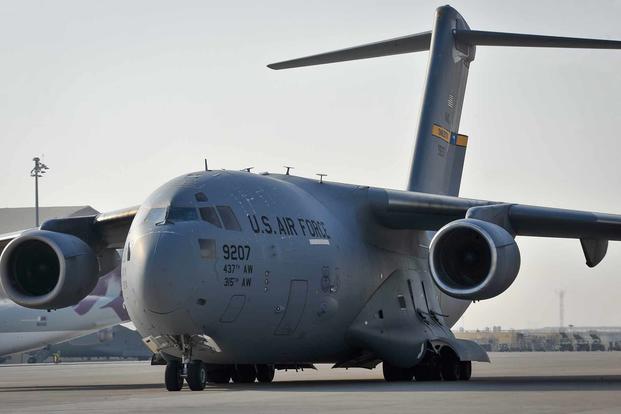The Air Force command in charge of moving personnel and equipment around the globe is ready to play a bigger role in the kill chain for troops on the ground or for pilots in the air, according to its top commander.
Gen. Jacqueline Van Ovost, the only female four-star general at the Pentagon, said Monday that the command had recently airdropped palletized, simulated Joint Direct Attack Munition bombs, or JDAMs, off a C-17 Globemaster III transport aircraft to test out the ability to turn airlifters into bomb trucks.
Read Next: Air Force Unveils New 'E-Series' Designation for Advanced Aircraft and Weapons
In later phases, there will be an "actual launch of an actual missile that actually gets fired," Van Ovost said during the Air Force Association's 2020 virtual Air, Space and Cyber conference.
The AMC experiment was similar to Air Force Special Operations Command's Cargo Launch Expendable Air Vehicles with Extended Range, or CLEAVER, test earlier this year, except the CLEAVER's pallet drop came off an MC-130J Commando II, which is already configured to airdrop weapons.
"It's a little different from what special operations is doing," Van Ovost said. "The concept, once fully matured, is for these munitions to behave just as if they were dropped from a bomber aircraft -- separate from the aircraft, ignite their motors, fly to predesignated waypoints and altitudes, then strike their targets."
The AMC experiment is not meant to replace any global strike bomber roles, she added.
The recent exercises were one of many the Air Force is conducting to test its Advanced Battle Management System (ABMS), designed to leverage air and space platforms to fuse together, process, and share data from around the world. Another test during the same exercise earlier this month showed the command's ability to flex the cargo aircraft in multiple ways, Van Ovost said.
A C-17 with enhanced communications relayed real-time coordinates to the Marine Corps' High Mobility Artillery Rocket System, or HIMARS, while on board; once the wheeled rocket launcher system rolled off the aircraft, it was locked and loaded and ready to go, she said.
"We were able to keep the Marine Corps HIMARS vehicle spun up the entire time it was in the airplane. It knew where it was and knew what the situational awareness was on the ground with the operational picture, and it could be retargeted in flight such that when it got off the airplane, it could immediately employ and, if you wanted to, roll right back onto the C-17 and take off out of there before an enemy can determine its location," Van Ovost said.
"We recognize that we actually can bring more to the fight than we have been," she said.
Tactical Reach
Just as the Air Force is gearing up for its airmen to be multi-capable -- executing skills beyond their functional area -- so should its aircraft and weapons in the digital realm, Van Ovost said in a separate interview with Military.com last week.
For that, she envisions that larger aircraft -- like C-17s, C-5 Super Galaxies and even the service's tankers -- will take on data-relay equipment or communication nodes to provide tactical datalinks for all in the battlespace, whether in close proximity or beyond line of sight.
"Our airplanes are going to be at the forward edge; they're going to be there. Our tankers are going to be there or airlift or tactical airlift is going to be there. So why wouldn't we augment the joint force [capability] and provide the Navy and Marine Corps and Army and Air Force the comms that they need and the data that they need to stay ahead so they can close the kill chain faster?" Van Ovost said Thursday.
The idea dates back nearly two decades to the onset of the Afghanistan and Iraq wars, when communications in the austere environment were hard to come by.
But instead of building an airplane whose sole purpose is to act as a data node, the military should use one of its many existing, spacious aircraft that are powerful enough to create an airborne network for multiple weapons systems -- which is where Air Mobility Command comes in, Van Ovost said.
If troops need to relay imagery, video, signals or communications beyond the transmittable range -- even if this transfer is cut off or jammed by enemies -- AMC aircraft can act as an aerial booster, she added. For example, the KC-46 Pegasus, the service's newest tanker, already has communications systems on board that allow it to be configured into a relay.
"I am talking about assured command and control for the forward joint force, and our ability to bring forward beyond line-of-sight capabilities to tie in our joint force together -- our ground forces to our fifth-gen forces to our fourth-gen forces -- to tie them in through a network and use the power and the location of, for example, airlifters and tankers who will be in the battlespace," Van Ovost said.
There are limitations: Enemies would target cargo or tanker aircraft loitering high above the battlespace and providing critical intelligence or data, so those pilots would need their own "situational awareness so they can understand what … the real threat is before we have to think about scramming, turning around and getting out of that location," she said Monday.
Van Ovost said that AMC continues to study "self-protection capabilities of our airplanes."
Some airlifters, such as C-130 Hercules aircraft, carry decoy flares, designed to draw a rocket to lock onto it instead of the aircraft. But it doesn't have offensive capabilities.
"As this thing evolves, we'll see what we actually need in the future and how we can use the joint force to be more protected," she said.
-- Oriana Pawlyk can be reached at oriana.pawlyk@military.com. Follow her on Twitter at @Oriana0214.
Related: A Fighter Pilot Will Dogfight an AI-Controlled Jet in 2024, Esper Says












